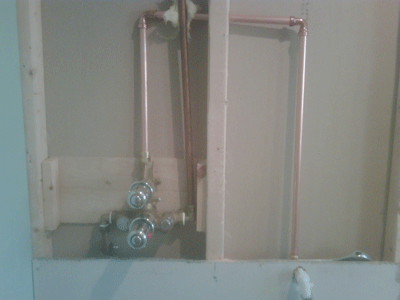I'm refitting and re-tiling our en-suite, got as far as plumbing in the new thermo mixer shower but I can't get decent pressure when I lift it above head height. It turns to a dribble.
Its an open vented heating system, hot water is piped upwards to valve and the cold water comes downwards from tank into valve.
The old shower worked fine and was a similar thermo concealed mixer.
Heres a photo (hopefully it works)

Is the low pressure simply because there are too many elbows?
I didn't want the bulkhead directly above the valve controls as the shower cord would overhang them.
I had the fit loads of PFTE to the hot/cold inlet elbows on the valve to get them pointing in right direction securely, is this safe or prone to leaks?
Any tips appreciated, thanks. :?
Heres a link to the shower if it helps
Google "plumbworld.co.uk/triton-alcor-dual-control-2767-20362?CAWELAID=408198304&ctype=2&gclid=CPqRnIeqjaYCFQkf4QodUhXUog"


